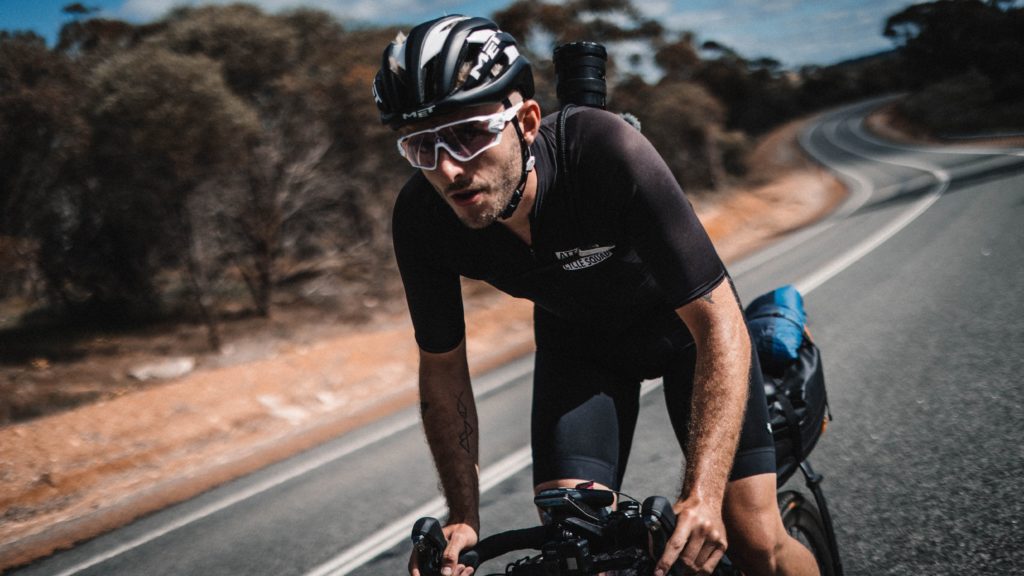We were fascinated by the recent video from UK bike Vlogger, Francis Cade – video at bottom of the page, showing the indoor wind tunnel testing of the AeroPack vs other kinds of bikepacking equipment. Francis took the most likely setups for bikepacking, and pitted them against each other to find out where the differences come from.
Francis heads to the Boardman Performance Centre wind tunnel with Xavier Disley, PhD, from AeroCoach (The Aero Experts) to test some of the most popular bikepacking setups and see what difference they make to a bike’s aerodynamics – like us, you’ll be astounded by the results.

Now, you might be asking, why on earth does that matter? I’m only riding an average 25kmph an hour over the day; I don’t need to go fast. Well, think about it like this: with a better kit set-up, over long distances you can save yourself time – that might mean more sleep or less riding after dark – and also energy, meaning you can be more calorie-efficient. You might argue that these might be marginal differences, but feeling fast (whether you’re racing on your own or trying to keep up with your bike packing buddies) can not only give you the physical edge but can also be a big mental boost. And it’s not just time on the bike: with user-friendly bike packing set-ups you’ll save time off the bike, as well as on it.
What did Francis Uncover?
Firstly, a little bit about aerodynamic drag. Aerodynamic drag is the force that opposes a cyclist as they travel through the air. It can be calculated by multiplying the Coefficient of drag (Cd) by the frontal Area (A) of the cylist+bike+gear. More accurately, though it can be measured directly in a wind tunnel using calibrated force gauges. These are the key findings from the test. All drag force measurements have been converted to ‘pedalling power’ whilst travelling at 25kmh:
| Bikepacking Equipment | Power Penalty (travelling at 25kmh) | Time Penalty (over 8 hour, 200km ride) |
| 2 x water bottles (750ml per side) on front forks | 3 Watts | 3.5 minutes |
| Front bar bag (2.5 litres) | 8.5 Watts | 9.9 minutes |
| Tailfin AeroPack Carbon X Rigid Seat Pack (~20 litres) | -2 Watts (it makes you FASTER) | 2.3 minutes LESS |
| 2 x Tailfin SL22 side panniers (22 litres each side) | 7 Watts | 8.2 minutes |
| Full Setup (wedge frame bag, handlebar bag, 2 bottles on fork, AeropPack and 2 side panniers) | 15.8 Watts | 17.5 minutes |
There are three standout points from these measurements:
- These measurements were all captured with a wind speed of 25kmh. If you were travelling faster then the watt savings wouldn’t just be a little larger, but significantly larger as the force scales non-linearly. For example, if you were riding at TT speed of 50kmh with 2 bottles on the fork, instead of it causing a 3 watt penalty it would now cause a 20 watt penalty.
- Adding a front bar bag with a carrying capacity of 2.5 litres adds more drag than having two side panniers with a combined carrying capacity of 44 litres! This is likely due to the fact that the Tailfin panniers are relatively slimline and sit behind the riders legs which doesn’t add much to the frontal area.
- Adding the Tailfin AeroPack Carbon X (~20Litres) made Francis 2.5 watts FASTER @ 25kmh, because it effectively acts like a fairing behind the rider by reducing turbulence to make a more streamlined profile. Streamlining a shape reduced the Coefficient of drag. Yes, the AeroPack makes you just little bit faster.

So, what real-world difference do aerodynamics make?
The full bike packing set-up that Francis tested, consisting of wedge frame bag, front bar bag, 2 bottles on the front forks, an AeroPack and two side panniers, in total, came to a 15.8 watts penalty, equating to 17.5 mins over 200km ride (8 hours) or an additional 130 calories per hour. Not only that but if you’re needing to put in 10% of your overall power output to keep up with buddies riding more efficient set-up, you’re really going to start to feel the difference pretty quickly.
We contacted Xavier to get his feedback on the testing. This is what he had to say: “Hopefully this helps people understand that aerodynamics are important, even at lower speeds – and in the case of bikepacking or ultra distance racing/riding it’s interesting to look at the results differently. Converting aero drag savings into calorie savings for example is not something that is often thought of for normal racing, but becomes much more important when you’re out on the bike for so long that managing your energy expenditure is a huge part of your overall performance/enjoyment.”
The takeaways from this? Firstly, your set-up has to work for you and your bike packing set-up. If you don’t need a front bar bag, then great, you can get rid of it. But if you want to carry a lot of gear, then side panniers are better than a front bar bag. Secondly, marginal gains can really add up over a long-distance ride. They might not sound much on a per hour basis, but extrapolate this over a 500k or 1,000k distance, and you’ll really start to see why aerodynamics does have an important role to play in bikepacking.
For more content like this, join our community